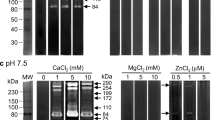Abstract
Since the hemolytic activity of extracts fromEntamoeba histolytica trophozoites previously described by us might determine at least partially the necrotic lesions of amebiasis, we have continued its characterization in vitro. Using rat erythrocytes as target cells, we have found that cytolysis byE. histolytica trophozoite extracts was (1) dose dependent, (2) localized mainly in a vesicular fraction whose absolute and specific activities were respectively 1.9 and 4.0 times higher than those of total extracts, (3) maximal at pH 8 in the presence of 1 mM Ca++, and (4) progressively lost by heating at 90°C or repeated freezing and thawing. From these results we infer that the major hemolytic factor ofE. histolytica may be a protein normally neutralized by an intracellular inhibitor or activated during fractionation.
Similar content being viewed by others
References
Alsever JB, Ainslie RB (1941) A new method for the preparation of dilute blood plasma and the operation of a complete transfusion service. NY State J Med 41:126–135
Bernheimer AW (1970) Cytolytic toxins of bacteria. In: Ajl SJ, Kadis S, Montie TC (eds), Microbial toxins. Academic Press New York, vol. 1, pp 183–212
Bos HJ (1979)Entamoeba histolytica: cytopathogenicity of intact amebae and cell-free extracts; isolation and characterization of an intracellular toxin. Exp Parasitol 47:369–377
Brandt H, Pérez-Tamayo R (1970) Pathology of human amebiasis. Hum Pathol 1:351–358
Diamond LS (1968) Techniques of axenic cultivation ofEntamoeba histolytica Schaudinn, 1903 andE. histolytica-like amebae. J Parasitol 54:1047–1056
Eaton RDP, Meerovitch E, Costerton JW (1970) The functional morphology of pathogenicity inEntamoeba histolytica. Ann Trop Med Parasitol 64:299–304
Jarumilinta R, Kradolfer F (1964) The toxic effect ofEntamoeba histolytica on leucocytes. Ann Trop Med Parasitol 58:375–381
Knight R, Bird RG, McCaul TF (1975) Fine structural changes atEntamoeba histolytica rabbit kidney cell (RK13) interface. Ann Trop Med Parasitol 69:197–202
López-Revilla R, Said-Fernández S (1980) Cytopathogenicity ofEntamoeba histolytica: hemolytic activity of trophozoite homogenates. Am J Trop Med Hyg 29:209–212
Lowry OH, Rosebrough NS, Farr AL, Randall RJ (1951) Protein measurement with the Folin phenol reagent. J Biol Chem 183:265–275
Lushbaugh WB, Kairalla AB, Cantey JR, Hofbauer AF, Pittman FE (1979) Isolation of a cytotoxinenterotoxin fromEntamoeba histolytica. J Inf Dis 139:9–17
Mattern CFT, Keister DB, Caspar NP (1980)Entamoeba histolytica “toxin”: fetuin-neutralizable and lectin-like. Am J Trop Med Hyg 29:26–30
Neal RA (1971) Pathogenesis of amebiasis. Bull NY Acad Med 47:462–468
Ravdin JI, Croft BY, Guerrant RL (1980) Cytopathogenic mechanisms ofEntamoeba histolytica. J Exp Med 152:377–390
Said-Fernández S, López-Revilla R (1976) Electrophoretic characterization of proteins from four axenicEntamoeba strains. In: Sepúlveda B, Diamond LS (eds) Amebiasis — Proceedings of the International Conference on Amebiasis, Instituto Mexicano del Seguro Social Mexico City, pp 104–111
Said-Fernández S, López-Revilla R (1978) Actividad citopatogénica en extractos de trofozoitos deEntamoeba histolytica. Arch Invest Med 9 (Supp. 1):151–152
Thelestam M, Möllby R (1979) Classification of microbial, plant and animal cytolysins based on their membrane damaging effects on human fibroblasts. Biochim Biophys Acta 557:156–169
Author information
Authors and Affiliations
Rights and permissions
About this article
Cite this article
Said-Fernández, S., López-Revilla, R. Subcellular distribution and stability of the major hemolytic activity ofEntamoeba histolytica trophozoites. Z. Parasitenkd. 67, 249–254 (1982). https://doi.org/10.1007/BF00927659
Accepted:
Issue Date:
DOI: https://doi.org/10.1007/BF00927659




